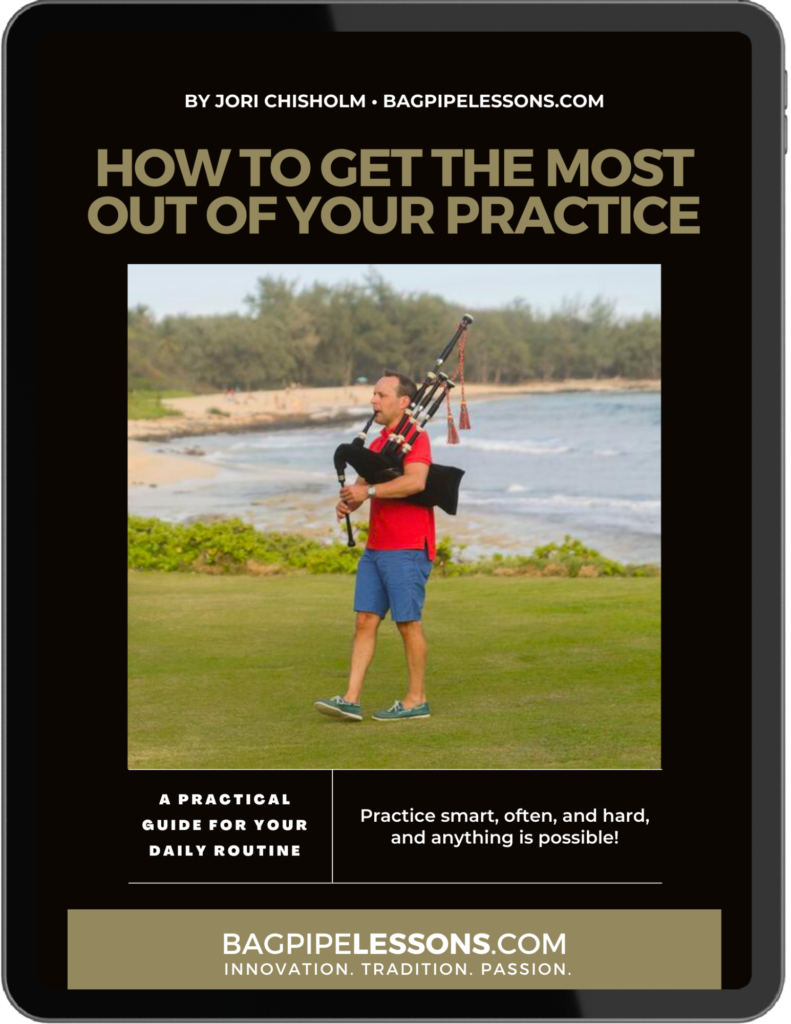
AS FEATURED IN

Power Doublings: The Ultimate Fingering Exercise to Elevate Your Piping Technique
by Jori Chisholm, Founder of BagpipeLessons.com
Last Updated: April 11, 2025
I’m Jori Chisholm from BapgipeLessons.com. Today’s exercise focuses on mastering the most common embellishment in all pipe tunes: doublings. In this video, part of our popular series of power exercises, we focus on perfecting your bagpipe fingering technique for doublings. Whether you’re playing slow airs, marches, strathspeys, reels, jigs, or hornpipes, mastering doublings is key to bringing your music to life. Download the free Power Doublings exercise from our website and join our Inner Circle membership for exclusive access to hundreds of lessons, tunes, videos, and live classes designed to elevate your piping to the next level. Whether you’re just starting out or have years of experience, this video will provide you with the insights and techniques to play doublings flawlessly every time. Let’s transform your piping together!
Watch the video and scroll down to read the full video script.
Video Transcript: Today, I’m going to show you another one of my all-time favorite exercises to help you improve your bagpipe fingering technique. It’s from my popular series of Power Exercises and this one focuses on the most common embellishment in all pipe tunes and that is Doublings. These are found in just about every pipe tune, all types of slow airs, marches, strathspeys, reels, jigs, and hornpipes. You can download my Power Doublings exercise for free and play along. I’ll teach you the three things that make a perfect doubling and share with you my secrets for how to practice your doubings so that you can play them perfectly every time.
It’s part of my series I’ve created that I call the Power Exercises. It’s designed to improve your fingering so your gracenotes are executed flawlessly so you can play your tunes with consistency and confidence. The Power series, which also includes Power GDEs, Power Tachums, Power Strathspey Triplets, and more, is available exclusively to members of my BagpipeLessons.com Inner Circle. Membership in my Inner Circle gives you complete access to all of these exercises and hundreds of lessons, videos, tunes, and exercises and weekly live classes with me to help you take your piping to the next level. Whether you are a brand new piper or have lots of experience there’s something for you. Learn more and join today at BagpipeLessons.com/membership.
I designed the Power Doublings to help you master your doublings so you can execute them cleanly with control, to deliver a distinct and precise rhythm. It focuses on the clarity and spacing between the two gracenotes. The rhythm of the doubling should be easy to hear, with the initial gracenote landing precisely on the beat.
The Power Doublings exercise is divided into two sections. The first section serves as a warm-up and introduces a sequence of notes ascending and descending the scale, each with a high G gracenote. This gets you familiar with the note pattern, and you can practice putting the gracenote perfectly on the beat.
In the second section, we replay the sequence of notes from the first part but now we play doublings instead of single gracenotes. The objective here is to achieve the “perfect doubling,” characterized by two small, crisp gracenotes separated by a melody note, what I call the “theme note” of the doubling. This theme note is identical to the note following the doubling and also gives the doubling its name. For instance, an F doubling consists of a high G gracenote on F (the theme note), followed by another high G gracenote to F—the main note of the doubling. In some of the older piping books, they referred to this as a “double F,” which emphasizes the presence of the two F notes. The first gracenote introduces the doubling by accenting the beat, while the second gracenote serves to separate the theme note in the middle of the doubling from the note that follows the doubling.
If you look at the E doubling, you’ll see a high G gracenote to E followed by an F gracenote to E. This forms the two Es, hence an E doubling or, as older texts might call it, a “double E.” So, the pattern is always High G Gracenote-theme note-second gracenote-final note. This pattern holds perfectly for every doubling from F down to Low G.
The perfect doubling consists of two small, crisp gracenote with the first high G gracenote played right on the beat AND a good separation between the two gracenotes so you can hear the theme note. This separation is what creates the rhythm of the doubling. If the gracenotes are too close together, you can’t hear the theme note and the doubling is crushed. To fix a crushed doubling you need to have more theme note, which means you need to wait longer before you plate the second gracenote. This is the key. Do NOT make your gracenotes bigger. Bigger gracenotes make your playing sloppy and slow. You want two small gracenote with separation between them.
You’ll notice that Power Doublings does not cover the High A and High G Doublings. Even though they have the name “doubling” they are different from the doublings from F on down, so they are not included in this exercise.
While practicing this exercise, remember to maintain good form: keep your hands relaxed and fingers light on the chanter—avoid tightening up. If your hands tire or stiffen, take a short break to loosen them. Ensure your fingers stay close to the chanter for clean, quick playing and be alert for any crossing noises. Always read the music, even if you know the exercise by heart, to bolster your sight-reading skills. A steady foot tap is crucial for consistent timing. Start slow to master control, then gradually increase speed as your confidence builds.
A metronome, like the Piper’s Metronome™ I designed, is vital for keeping a solid beat and honing your timing and rhythm. Check it out at https://pipersmetronome.com/ It’s packed with features tailored for pipers and available for download on Apple and Android devices. Playing along with a metronome ensures your notes are steady.
Also, If the video’s tempo doesn’t match your pace, adjust the YouTube playback speed to find a comfortable starting point. Just click on the little gear icon in the bottom right corner of the video player, click ‘Playback Speed’ and try a slower tempo that works best for you. Slow practice leads to mastery. Get control and consistency first, then build speed.
Now, with your practice chanter or pipes ready, let’s play some Power Doublings!
Feel free to leave questions or share your piping experiences in the comments below. If there’s a specific tune or piping technique you’re curious about, I’m here to help! Enjoyed this exercise?
Inside my BagpipeLessons.com Inner Circle, you’ll find a ton of resources just like this. Membership grants you access to weekly live classes for all skill levels, an extensive lesson library on every piping topic imaginable, and personalized support from me. Discover more and join me by visiting https://bagpipelessons.com/membership/.
For more free content, including videos, lessons, and guides, visit BagpipeLessons.com/learn. Don’t forget to download the ‘How to Get the Most Out of Your Practice‘ guide, the link in the description below. And Hit subscribe and the notification bell to keep up with new videos here on the BagpipeLessons.com YouTube Channel including more of these fantastic exercises from my Power Series.
Happy Piping!




